Plasmonic Modification of Epitaxial Nanostructures for the Development of a Highly Efficient SERS Platform
Abstract
1. Introduction
1.1. Epitaxial Growth of Semiconducting Nanostructures
1.2. Current Application of Epitaxial Semiconducting Nanostructures
2. Optical Properties of Chosen Semiconducting Nanostructures Formed via Epitaxial Method
3. Plasmonic Functionalization
3.1. Modification by Plasmonic Noble Metals
3.1.1. Modification by Plasmonic Noble Metal Nanoparticle Deposition
3.1.2. Modification by Plasmonic Noble Metal Thin Film Deposition
3.2. Modification by Plasmonic Non-Metallic Nanostructures
4. Conclusions
Author Contributions
Funding
Data Availability Statement
Conflicts of Interest
References
- Jatoi, A.S.; Ahmed Khan, F.S.; Mazari, S.A.; Mubarak, N.M.; Abro, R.; Ahmed, J.; Ahmed, M.; Baloch, H.; Sabzoi, N. Current Applications of Smart Nanotextiles and Future Trends. In Nanosensors and Nanodevices for Smart Multifunctional Textiles; Elsevier: Amsterdam, The Netherlands, 2021; pp. 343–365. [Google Scholar] [CrossRef]
- Wu, Y.; Yang, P. Direct Observation of Vapor−Liquid−Solid Nanowire Growth. J. Am. Chem. Soc. 2001, 123, 3165–3166. [Google Scholar] [CrossRef]
- Li, A.; Zou, J.; Han, X. Growth of III-V Semiconductor Nanowires and Their Heterostructures. Sci. China Mater. 2016, 59, 51–91. [Google Scholar] [CrossRef][Green Version]
- Noor Mohammad, S. Why Self-Catalyzed Nanowires Are Most Suitable for Large-Scale Hierarchical Integrated Designs of Nanowire Nanoelectronics. J. Appl. Phys. 2011, 110, 084310. [Google Scholar] [CrossRef]
- Johnson, N.J.J.; Korinek, A.; Dong, C.; van Veggel, F.C.J.M. Self-Focusing by Ostwald Ripening: A Strategy for Layer-by-Layer Epitaxial Growth on Upconverting Nanocrystals. J. Am. Chem. Soc. 2012, 134, 11068–11071. [Google Scholar] [CrossRef] [PubMed]
- Lu, W.; Lieber, C.M. Semiconductor Nanowires. J. Phys. D Appl. Phys. 2006, 39, R387–R406. [Google Scholar] [CrossRef]
- Meng, J.; Li, Z. Schottky-Contacted Nanowire Sensors. Adv. Mater. 2020, 32, e2000130. [Google Scholar] [CrossRef]
- Chen, Y.; Hrachowina, L.; Barrigon, E.; Beech, J.P.; Alcer, D.; Lyttleton, R.; Jam, R.J.; Samuelson, L.; Linke, H.; Borgström, M. Semiconductor Nanowire Array for Transparent Photovoltaic Applications. Appl. Phys. Lett. 2021, 118, 191107. [Google Scholar] [CrossRef]
- Li, X.; Liu, X.; Li, Y.; Gao, D.; Cao, L. Using Novel Semiconductor Features to Construct Advanced ZnO Nanowires-Based Ultraviolet Photodetectors: A Brief Review. IEEE Access 2021, 9, 11954–11973. [Google Scholar] [CrossRef]
- Dasgupta, N.P.; Sun, J.; Liu, C.; Brittman, S.; Andrews, S.C.; Lim, J.; Gao, H.; Yan, R.; Yang, P. 25th Anniversary Article: Semiconductor Nanowires—Synthesis, Characterization, and Applications. Adv. Mater. 2014, 26, 2137–2184. [Google Scholar] [CrossRef]
- Seifert, W.; Borgström, M.; Deppert, K.; Dick, K.A.; Johansson, J.; Larsson, M.W.; Mårtensson, T.; Sköld, N.; Patrik, T.; Svensson, C.; et al. Growth of One-Dimensional Nanostructures in MOVPE. J. Cryst. Growth 2004, 272, 211–220. [Google Scholar] [CrossRef]
- Hersee, S.D.; Sun, X.; Wang, X. The Controlled Growth of GaN Nanowires. Nano Lett. 2006, 6, 1808–1811. [Google Scholar] [CrossRef] [PubMed]
- Wang, N.; Cai, Y.; Zhang, R.Q. Growth of Nanowires. Mater. Sci. Eng. R Rep. 2008, 60, 1–51. [Google Scholar] [CrossRef]
- Vanmaekelbergh, D.; van Vugt, L.K. ZnO Nanowire Lasers. Nanoscale 2011, 3, 2783. [Google Scholar] [CrossRef]
- Duan, X.; Huang, Y.; Agarwal, R.; Lieber, C.M. Single-Nanowire Electrically Driven Lasers. Nature 2003, 421, 241–245. [Google Scholar] [CrossRef]
- Johnson, J.C.; Choi, H.-J.; Knutsen, K.P.; Schaller, R.D.; Yang, P.; Saykally, R.J. Single Gallium Nitride Nanowire Lasers. Nat. Mater. 2002, 1, 106–110. [Google Scholar] [CrossRef] [PubMed]
- Saxena, D.; Mokkapati, S.; Parkinson, P.; Jiang, N.; Gao, Q.; Tan, H.H.; Jagadish, C. Optically Pumped Room-Temperature GaAs Nanowire Lasers. Nat. Photonics 2013, 7, 963–968. [Google Scholar] [CrossRef]
- Zhu, H.; Fu, Y.; Meng, F.; Wu, X.; Gong, Z.; Ding, Q.; Gustafsson, M.V.; Trinh, M.T.; Jin, S.; Zhu, X.-Y. Lead Halide Perovskite Nanowire Lasers with Low Lasing Thresholds and High Quality Factors. Nat. Mater. 2015, 14, 636–642. [Google Scholar] [CrossRef]
- Peng, K.; Jevtics, D.; Zhang, F.; Sterzl, S.; Damry, D.A.; Rothmann, M.U.; Guilhabert, B.; Strain, M.J.; Tan, H.H.; Herz, L.M.; et al. Three-Dimensional Cross-Nanowire Networks Recover Full Terahertz State. Science 2020, 368, 510–513. [Google Scholar] [CrossRef]
- Zhang, A.; Zheng, G. Semiconductor Nanowires for Biosensors. In Semiconductor Nanowires; Elsevier: Amsterdam, The Netherlands, 2015; pp. 471–490. [Google Scholar] [CrossRef]
- Li, H.; Li, D.; Chen, H.; Yue, X.; Fan, K.; Dong, L.; Wang, G. Application of Silicon Nanowire Field Effect Transistor (SiNW-FET) Biosensor with High Sensitivity. Sensors 2023, 23, 6808. [Google Scholar] [CrossRef]
- Krajczewski, J.; Michałowska, A.; Čtvrtlík, R.; Nožka, L.; Tomáštík, J.; Václavek, L.; Turczyniak-Surdacka, S.; Bieńskowski, K.; Solarska, R. The Battle for the Future of SERS—TiN vs. Au Thin Films with the Same Morphology. Appl. Surf. Sci. 2023, 618, 156703. [Google Scholar] [CrossRef]
- Otto, A. Excitation of Nonradiative Surface Plasma Waves in Silver by the Method of Frustrated Total Reflection. Zeitschrift für Phys. A Hadron. Nucl. 1968, 216, 398–410. [Google Scholar] [CrossRef]
- Kretschmann, E.; Raether, H. Notizen: Radiative Decay of Non Radiative Surface Plasmons Excited by Light. Zeitschrift für Naturforsch. A 1968, 23, 2135–2136. [Google Scholar] [CrossRef]
- Turkevich, J.; Stevenson, P.C.; Hillier, J. A Study of the Nucleation and Growth Processes in the Synthesis of Colloidal Gold. Discuss. Faraday Soc. 1951, 11, 55. [Google Scholar] [CrossRef]
- Turkevich, J. Colloidal Gold. Part I. Gold Bull. 1985, 18, 86–91. [Google Scholar] [CrossRef]
- Lee, P.C.; Meisel, D. Adsorption and Surface-Enhanced Raman of Dyes on Silver and Gold Sols. J. Phys. Chem. 1982, 86, 3391–3395. [Google Scholar] [CrossRef]
- Langille, M.R.; Personick, M.L.; Zhang, J.; Mirkin, C.A. Defining Rules for the Shape Evolution of Gold Nanoparticles. J. Am. Chem. Soc. 2012, 134, 14542–14554. [Google Scholar] [CrossRef]
- Wu, H.-L.; Chen, C.-H.; Huang, M.H. Seed-Mediated Synthesis of Branched Gold Nanocrystals Derived from the Side Growth of Pentagonal Bipyramids and the Formation of Gold Nanostars. Chem. Mater. 2009, 21, 110–114. [Google Scholar] [CrossRef]
- Nikoobakht, B.; El-Sayed, M.A. Preparation and Growth Mechanism of Gold Nanorods (NRs) Using Seed-Mediated Growth Method. Chem. Mater. 2003, 15, 1957–1962. [Google Scholar] [CrossRef]
- Burrows, N.D.; Harvey, S.; Idesis, F.A.; Murphy, C.J. Understanding the Seed-Mediated Growth of Gold Nanorods through a Fractional Factorial Design of Experiments. Langmuir 2017, 33, 1891–1907. [Google Scholar] [CrossRef]
- Scarabelli, L.; Coronado-Puchau, M.; Giner-Casares, J.J.; Langer, J.; Liz-Marzán, L.M. Monodisperse Gold Nanotriangles: Size Control, Large-Scale Self-Assembly, and Performance in Surface-Enhanced Raman Scattering. ACS Nano 2014, 8, 5833–5842. [Google Scholar] [CrossRef]
- Sun, Z.; Umar, A.; Zeng, J.; Luo, X.; Song, L.; Zhang, Z.; Chen, Z.; Li, J.; Su, F.; Huang, Y. Highly Pure Gold Nanotriangles with Almost 100% Yield for Surface-Enhanced Raman Scattering. ACS Appl. Nano Mater. 2022, 5, 1220–1231. [Google Scholar] [CrossRef]
- Kou, X.; Ni, W.; Tsung, C.-K.; Chan, K.; Lin, H.-Q.; Stucky, G.D.; Wang, J. Growth of Gold Bipyramids with Improved Yield and Their Curvature-Directed Oxidation. Small 2007, 3, 2103–2113. [Google Scholar] [CrossRef] [PubMed]
- Dovgolevsky, E.; Haick, H. Direct Observation of the Transition Point Between Quasi-Spherical and Cubic Nanoparticles in a Two-Step Seed-Mediated Growth Method. Small 2008, 4, 2059–2066. [Google Scholar] [CrossRef]
- Zhang, J.; Langille, M.R.; Personick, M.L.; Zhang, K.; Li, S.; Mirkin, C.A. Concave Cubic Gold Nanocrystals with High-Index Facets. J. Am. Chem. Soc. 2010, 132, 14012–14014. [Google Scholar] [CrossRef]
- Wiley, B.; Herricks, T.; Sun, Y.; Xia, Y. Polyol Synthesis of Silver Nanoparticles: Use of Chloride and Oxygen to Promote the Formation of Single-Crystal, Truncated Cubes and Tetrahedrons. Nano Lett. 2004, 4, 1733–1739. [Google Scholar] [CrossRef]
- Zhao, T.; Sun, R.; Yu, S.; Zhang, Z.; Zhou, L.; Huang, H.; Du, R. Size-Controlled Preparation of Silver Nanoparticles by a Modified Polyol Method. Colloids Surf. A Physicochem. Eng. Asp. 2010, 366, 197–202. [Google Scholar] [CrossRef]
- Callegari, A.; Tonti, D.; Chergui, M. Photochemically Grown Silver Nanoparticles with Wavelength-Controlled Size and Shape. Nano Lett. 2003, 3, 1565–1568. [Google Scholar] [CrossRef]
- Yin, B.; Ma, H.; Wang, S.; Chen, S. Electrochemical Synthesis of Silver Nanoparticles under Protection of Poly(N-Vinylpyrrolidone). J. Phys. Chem. B 2003, 107, 8898–8904. [Google Scholar] [CrossRef]
- Rodríguez-Sánchez, L.; Blanco, M.C.; López-Quintela, M.A. Electrochemical Synthesis of Silver Nanoparticles. J. Phys. Chem. B 2000, 104, 9683–9688. [Google Scholar] [CrossRef]
- Tsuji, T.; Iryo, K.; Watanabe, N.; Tsuji, M. Preparation of Silver Nanoparticles by Laser Ablation in Solution: Influence of Laser Wavelength on Particle Size. Appl. Surf. Sci. 2002, 202, 80–85. [Google Scholar] [CrossRef]
- Mafuné, F.; Kohno, J.; Takeda, Y.; Kondow, T.; Sawabe, H. Formation of Gold Nanoparticles by Laser Ablation in Aqueous Solution of Surfactant. J. Phys. Chem. B 2001, 105, 5114–5120. [Google Scholar] [CrossRef]
- Kołątaj, K.; Ambroziak, R.; Kędziora, M.; Krajczewski, J.; Kudelski, A. Formation of Bifunctional Conglomerates Composed of Magnetic γ-Fe2O3 Nanoparticles and Various Noble Metal Nanostructures. Appl. Surf. Sci. 2019, 470, 970–978. [Google Scholar] [CrossRef]
- Fujiwara, K.; Kasaya, H.; Ogawa, N. Gold Nanoparticle Monolayer Formation on a Chemically Modified Glass Surface. Anal. Sci. 2009, 25, 241–248. [Google Scholar] [CrossRef] [PubMed]
- Kambayashi, M.; Zhang, J.; Oyama, M. Crystal Growth of Gold Nanoparticles on Indium Tin Oxides in the Absence and Presence of 3-Mercaptopropyl-Trimethoxysilane. Cryst. Growth Des. 2005, 5, 81–84. [Google Scholar] [CrossRef]
- Kim, K.; Lee, J.W.; Lee, H.B.; Shin, K.S. Novel Fabrication of Au Nanoparticle Films on Planar and Curved Surfaces of Glass and Fiber Materials. Langmuir 2009, 25, 9697–9702. [Google Scholar] [CrossRef]
- Jiang, Y.; Lu, Y.; Zhang, L.; Liu, L.; Dai, Y.; Wang, W. Preparation and Characterization of Silver Nanoparticles Immobilized on Multi-Walled Carbon Nanotubes by Poly(Dopamine) Functionalization. J. Nanoparticle Res. 2012, 14, 938. [Google Scholar] [CrossRef]
- Spampinato, V.; Parracino, M.A.; La Spina, R.; Rossi, F.; Ceccone, G. Surface Analysis of Gold Nanoparticles Functionalized with Thiol-Modified Glucose SAMs for Biosensor Applications. Front. Chem. 2016, 4, 8. [Google Scholar] [CrossRef]
- Ambroziak, R.; Krajczewski, J.; Pisarek, M.; Kudelski, A. Immobilization of Cubic Silver Plasmonic Nanoparticles on TiO2 Nanotubes, Reducing the Coffee Ring Effect in Surface-Enhanced Raman Spectroscopy Applications. ACS Omega 2020, 5, 13963–13972. [Google Scholar] [CrossRef]
- Krajczewski, J.; Ambroziak, R.; Turczyniak-Surdacka, S.; Dziubałtowska, M. WO3 Nanopores Array Modified by Au Trisoctahedral NPs: Formation, Characterization and SERS Application. Materials 2022, 15, 8706. [Google Scholar] [CrossRef]
- Laurenčíková, A.; Eliáš, P.; Hasenöhrl, S.; Kováč, J.; Szobolovszký, R.; Novák, J. GaP nanocones covered with silver nanoparticles for surface-enhanced Raman spectroscopy. Appl. Surf. Sci. 2018, 461, 149–159. [Google Scholar] [CrossRef]
- Novák, J.; Eliáš, P.; Hasenöhrl, S.; Laurenčíková, A.; Kováč, J.; Urbancovám, P.; Pudiš, D. Twinned nanoparticle structures for surface enhanced Raman scattering. Appl. Surf. Sci. 2020, 528, 146548. [Google Scholar] [CrossRef]
- Novák, J.; Laurenčíková, A.; Eliáš, P.; Hasenöhrl, S.; Sojková, M.; Dobrocka, E.; Kováč, J.; Kováč, J.; Ďurišová, J.; Pudiš, D. Nanorods and nanocones for advanced sensor applications. Appl. Surf. Sci. 2018, 461, 61–65. [Google Scholar] [CrossRef]
- Chien, F.-C.; Zhang, T.F.; Chen, C.; Nguyet Nguyen, T.A.; Wang, S.-Y.; Lai, S.M.; Cin, C.H.; Huang, C.-K.; Liu, C.-Y.; Lai, K.Y. Nanostructured InGaN Quantum Wells as a Surface-Enhanced Raman Scattering Substrate with Expanded Hot Spots. ACS Appl. Nano Mater. 2021, 4, 2614–2620. [Google Scholar] [CrossRef]
- Helmersson, U.; Lattemann, M.; Bohlmark, J.; Ehiasarian, A.P.; Gudmundsson, J.T. Ionized Physical Vapor Deposition (IPVD): A Review of Technology and Applications. Thin Solid Film. 2006, 513, 1–24. [Google Scholar] [CrossRef]
- Hong, C.; Kim, H.; Park, S.; Lee, C. Optical Properties of Porous Silicon Coated with Ultrathin Gold Film by RF-Magnetron Sputtering. J. Eur. Ceram. Soc. 2010, 30, 459–463. [Google Scholar] [CrossRef]
- Uosaki, K.; Shen, Y.; Kondo, T. Preparation of a Highly Ordered Au (111) Phase on a Polycrystalline Gold Substrate by Vacuum Deposition and Its Characterization by XRD, GISXRD, STM/AFM, and Electrochemical Measurements. J. Phys. Chem. 1995, 99, 14117–14122. [Google Scholar] [CrossRef]
- Barman, T.; Nozka, L.; Prochazka, V.; Michałowska, A.; Turczyniak-Surdacka, S.; Ctvrtlik, R.; Krajczewski, J. Morphology Tuned Plasmonic TiN Nanostructures Formed by Angle-Dependent Sputtering Process for SERS Measurements. J. Mater. Sci. 2023, 58, 14661–14672. [Google Scholar] [CrossRef]
- Krajczewski, J.; Dumiszewska, E.; Czolak, D.; Turczyniak Surdacka, S.; Kudelski, A. New, Epitaxial Approach to SERS Platform Preparation—InP Nanowires Coated by an Au Layer as a New, Highly Active, and Stable SERS Platform. Appl. Surf. Sci. 2023, 607, 155096. [Google Scholar] [CrossRef]
- Kudelski, A. Surface-Enhanced Raman Scattering Study of Monolayers Formed from Mixtures of 4-Mercaptobenzoic Acid and Various Aromatic Mercapto-Derivative Bases. J. Raman Spectrosc. 2009, 40, 2037–2043. [Google Scholar] [CrossRef]
- Carlsson, J.-O.; Martin, P.M. Chemical Vapor Deposition. In Handbook of Deposition Technologies for Films and Coatings; Elsevier: Amsterdam, The Netherlands, 2010; pp. 314–363. [Google Scholar] [CrossRef]
- O’Brien, P. Chemical Vapor Deposition. In Encyclopedia of Materials: Science and Technology; Elsevier: Amsterdam, The Netherlands, 2001; pp. 1173–1176. [Google Scholar] [CrossRef]
- Sun, X.; Li, H. Gold Nanoisland Arrays by Repeated Deposition and Post-Deposition Annealing for Surface-Enhanced Raman Spectroscopy. Nanotechnology 2013, 24, 355706. [Google Scholar] [CrossRef]
- Araújo, A.; Mendes, M.J.; Mateus, T.; Vicente, A.; Nunes, D.; Calmeiro, T.; Fortunato, E.; Águas, H.; Martins, R. Influence of the Substrate on the Morphology of Self-Assembled Silver Nanoparticles by Rapid Thermal Annealing. J. Phys. Chem. C 2016, 120, 18235–18242. [Google Scholar] [CrossRef]
- Berger, L.-M. Application of Hardmetals as Thermal Spray Coatings. Int. J. Refract. Met. Hard Mater. 2015, 49, 350–364. [Google Scholar] [CrossRef]
- Naik, G.V.; Schroeder, J.L.; Ni, X.; Kildishev, A.V.; Sands, T.D.; Boltasseva, A. Titanium Nitride as a Plasmonic Material for Visible and Near-Infrared Wavelengths. Opt. Mater. Express 2012, 2, 478. [Google Scholar] [CrossRef]
- Jen, Y.-J.; Lin, M.-J.; Cheang, H.-L.; Chan, T.-L. Obliquely Deposited Titanium Nitride Nanorod Arrays as Surface-Enhanced Raman Scattering Substrates. Sensors 2019, 19, 4765. [Google Scholar] [CrossRef]
- Kaisar, N.; Huang, Y.-T.; Jou, S.; Kuo, H.-F.; Huang, B.-R.; Chen, C.-C.; Hsieh, Y.-F.; Chung, Y.-C. Surface-Enhanced Raman Scattering Substrates of Flat and Wrinkly Titanium Nitride Thin Films by Sputter Deposition. Surf. Coat. Technol. 2018, 337, 434–438. [Google Scholar] [CrossRef]
- Zhao, F.; Xue, X.; Fu, W.; Liu, Y.; Ling, Y.; Zhang, Z. TiN Nanorods as Effective Substrate for Surface-Enhanced Raman Scattering. J. Phys. Chem. C 2019, 123, 29353–29359. [Google Scholar] [CrossRef]
- Mascaretti, L.; Barman, T.; Bricchi, B.R.; Münz, F.; Li Bassi, A.; Kment, Š.; Naldoni, A. Controlling the Plasmonic Properties of Titanium Nitride Thin Films by Radiofrequency Substrate Biasing in Magnetron Sputtering. Appl. Surf. Sci. 2021, 554, 149543. [Google Scholar] [CrossRef]
- Guler, U.; Suslov, S.; Kildishev, A.V.; Boltasseva, A.; Shalaev, V.M. Colloidal Plasmonic Titanium Nitride Nanoparticles: Properties and Applications. Nanophotonics 2015, 4, 269–276. [Google Scholar] [CrossRef]
- Guler, U.; Zemlyanov, D.; Kim, J.; Wang, Z.; Chandrasekar, R.; Meng, X.; Stach, E.; Kildishev, A.V.; Shalaev, V.M.; Boltasseva, A. Plasmonic Titanium Nitride Nanostructures via Nitridation of Nanopatterned Titanium Dioxide. Adv. Opt. Mater. 2017, 5, 1600717. [Google Scholar] [CrossRef]
- Wei, H.; Wu, M.; Dong, Z.; Chen, Y.; Bu, J.; Lin, J.; Yu, Y.; Wei, Y.; Cui, Y.; Wang, R. Composition, Microstructure and SERS Properties of Titanium Nitride Thin Film Prepared via Nitridation of Sol-Gel Derived Titania Thin Films. J. Raman Spectrosc. 2017, 48, 578–585. [Google Scholar] [CrossRef]
- Kan, X.; Deng, C.; Yu, C.; Ding, J.; Zhu, H. Synthesis, Electrochemical and Photoluminescence Properties of Titanium Nitride Nanoparticles. J. Mater. Sci. Mater. Electron. 2018, 29, 10624–10630. [Google Scholar] [CrossRef]
- Xia, F.; Yang, A.; Cui, W.; Li, Q. Preparation and Wear Assessment of Ultrasonic Electrodeposited Ni–TiN Thin Films. Ceram. Int. 2018, 44, 11070–11076. [Google Scholar] [CrossRef]
- Wu, H.; Wang, H.; Li, G. Metal Oxide Semiconductor SERS-Active Substrates by Defect Engineering. Analyst 2017, 142, 326–335. [Google Scholar] [CrossRef]
- Li, J.; Xu, X.; Huang, B.; Lou, Z.; Li, B. Light-Induced In Situ Formation of a Nonmetallic Plasmonic MoS2 /MoO3–x Heterostructure with Efficient Charge Transfer for CO2 Reduction and SERS Detection. ACS Appl. Mater. Interfaces 2021, 13, 10047–10053. [Google Scholar] [CrossRef] [PubMed]
- Patil, M.K.; Gaikwad, S.H.; Mukherjee, S.P. Phase- and Morphology-Controlled Synthesis of Tunable Plasmonic MoO3–x Nanomaterials for Ultrasensitive Surface-Enhanced Raman Spectroscopy Detection. J. Phys. Chem. C 2020, 124, 21082–21093. [Google Scholar] [CrossRef]
- He, R.; Lai, H.; Wang, S.; Chen, T.; Xie, F.; Chen, Q.; Liu, P.; Chen, J.; Xie, W. Few-Layered VdW MoO3 for Sensitive, Uniform and Stable SERS Applications. Appl. Surf. Sci. 2020, 507, 145116. [Google Scholar] [CrossRef]
- Yang, Y.; Li, J.; Zhang, M.; Song, P.; Lu, X.; Ding, Y. Universal and Simple MoO3 Substrate for Identification of SERS Enhancement Mechanism. J. Raman Spectrosc. 2021, 52, 1275–1280. [Google Scholar] [CrossRef]
- Kulikova, D.P.; Dobronosova, A.A.; Kornienko, V.V.; Nechepurenko, I.A.; Baburin, A.S.; Sergeev, E.V.; Lotkov, E.S.; Rodionov, I.A.; Baryshev, A.V.; Dorofeenko, A.V. Optical properties of tungsten trioxide, palladium, and platinum thin films for functional nanostructures engineering. Opt. Express. 2020, 28, 32049–32060. [Google Scholar] [CrossRef] [PubMed]
- Jiang, L.; Hu, Y.; Zhang, H.; Luo, X.; Yuan, R.; Yang, X. Charge-Transfer Resonance and Surface Defect-Dominated WO3 Hollow Microspheres as SERS Substrates for the MiRNA 155 Assay. Anal. Chem. 2022, 94, 6967–6975. [Google Scholar] [CrossRef]
- Shi, Y.; Liu, Q.; Hong, R.; Tao, C.; Wang, Q.; Lin, H.; Han, Z.; Zhang, D. SERS-Active WO3–x Thin Films with Tunable Surface Plasmon Resonance Induced by Defects from Thermal Treatment. Spectrochim. Acta Part A Mol. Biomol. Spectrosc. 2022, 268, 120686. [Google Scholar] [CrossRef]
- Hou, X.; Luo, X.; Fan, X.; Peng, Z.; Qiu, T. Plasmon-Coupled Charge Transfer in WO3–x Semiconductor Nanoarrays: Toward Highly Uniform Silver-Comparable SERS Platforms. Phys. Chem. Chem. Phys. 2019, 21, 2611–2618. [Google Scholar] [CrossRef] [PubMed]
- Riswana Barveen, N.; Wang, T.-J.; Chang, Y.-H.; Rajakumaran, R. Ultrasensitive and Reusable SERS Platform Based on Ag Modified WO3 Nanoflakes for Catechol Detection. Mater. Sci. Eng. B 2022, 282, 115753. [Google Scholar] [CrossRef]
- Zou, J.-W.; Li, Z.-D.; Kang, H.-S.; Zhao, W.-Q.; Liu, J.-C.; Chen, Y.-L.; Ma, L.; Hou, H.-Y.; Ding, S.-J. Strong Visible Light Absorption and Abundant Hotspots in Au-Decorated WO3 Nanobricks for Efficient SERS and Photocatalysis. ACS Omega 2021, 6, 28347–28355. [Google Scholar] [CrossRef] [PubMed]
- Juntaracena, K.; Yuangkaew, T.; Horprathum, M.; Triroj, N.; Jaroenapibal, P. Surface-Enhanced Raman Scattering Activities and Recyclability of Ag-Incorporated WO3 Nanofiber-Based Substrates. Vib. Spectrosc. 2021, 115, 103276. [Google Scholar] [CrossRef]
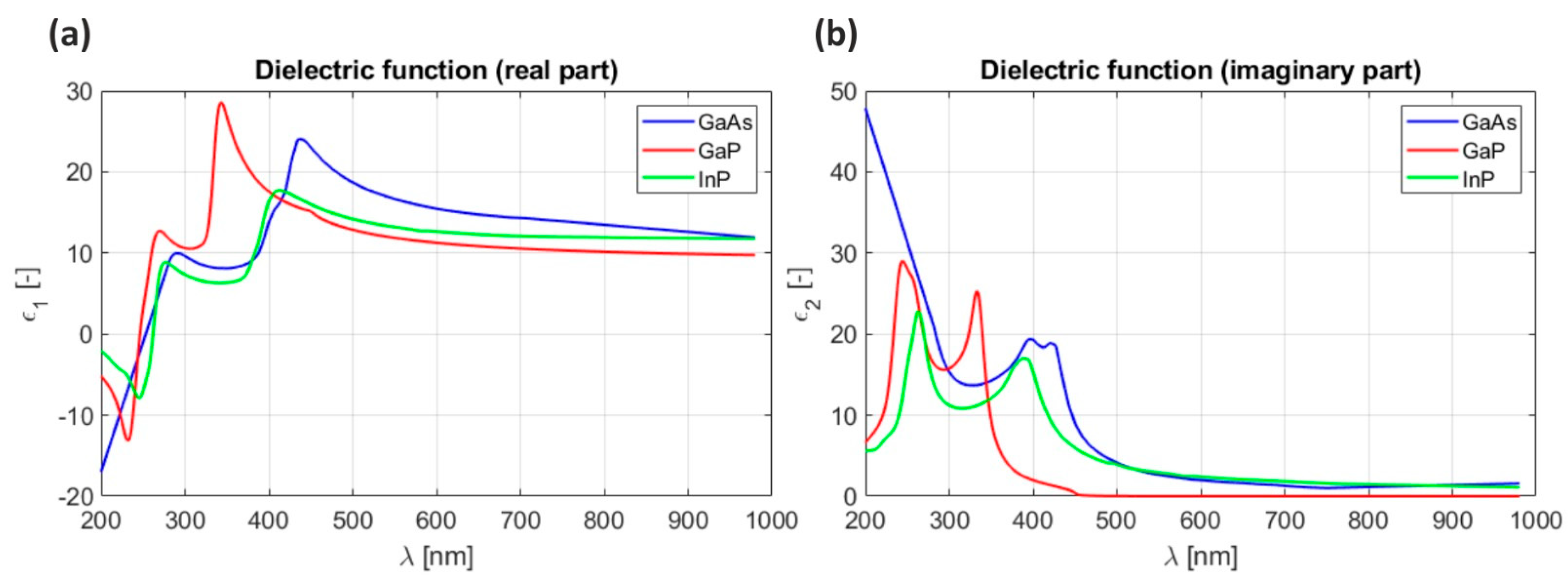
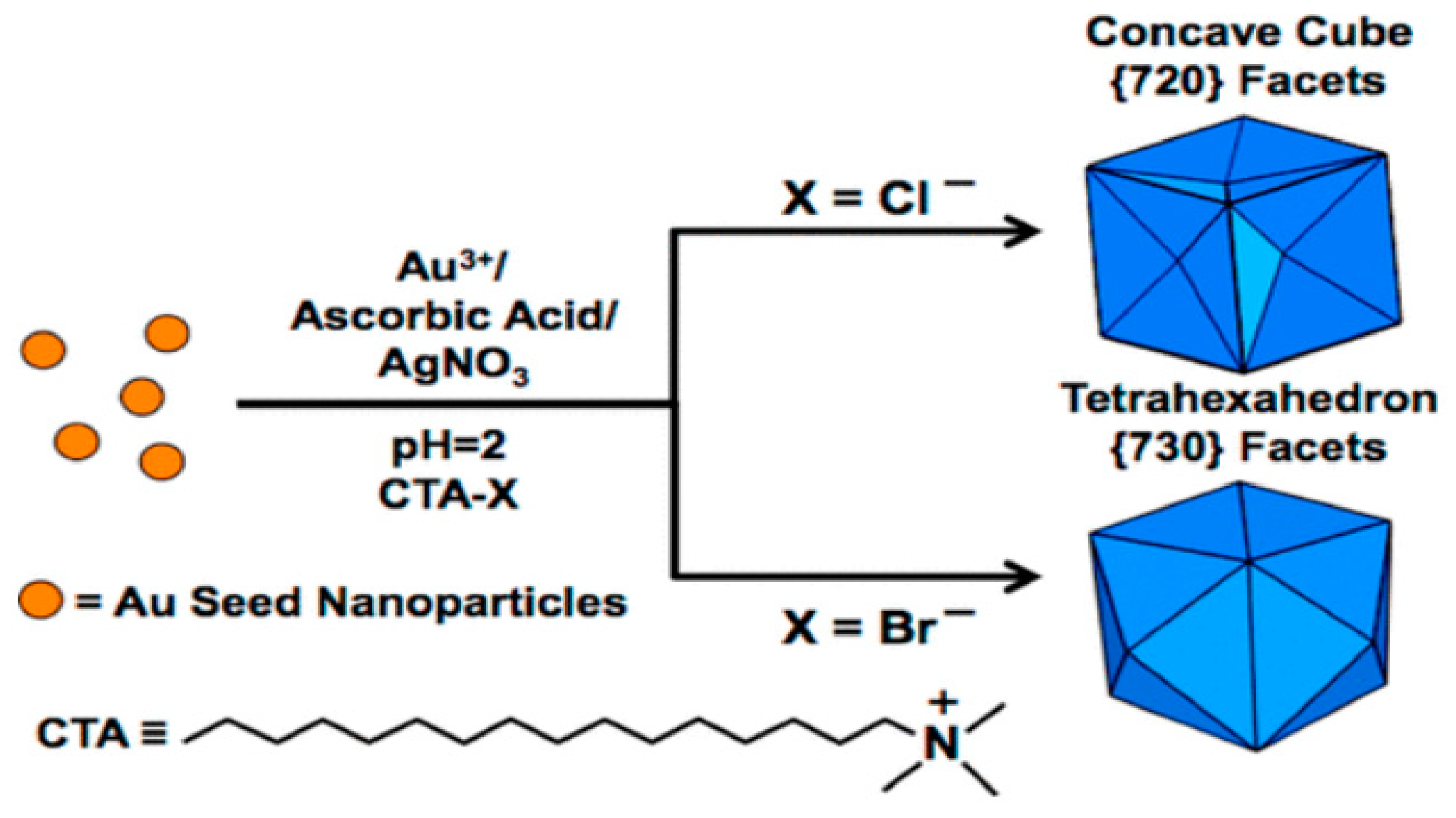

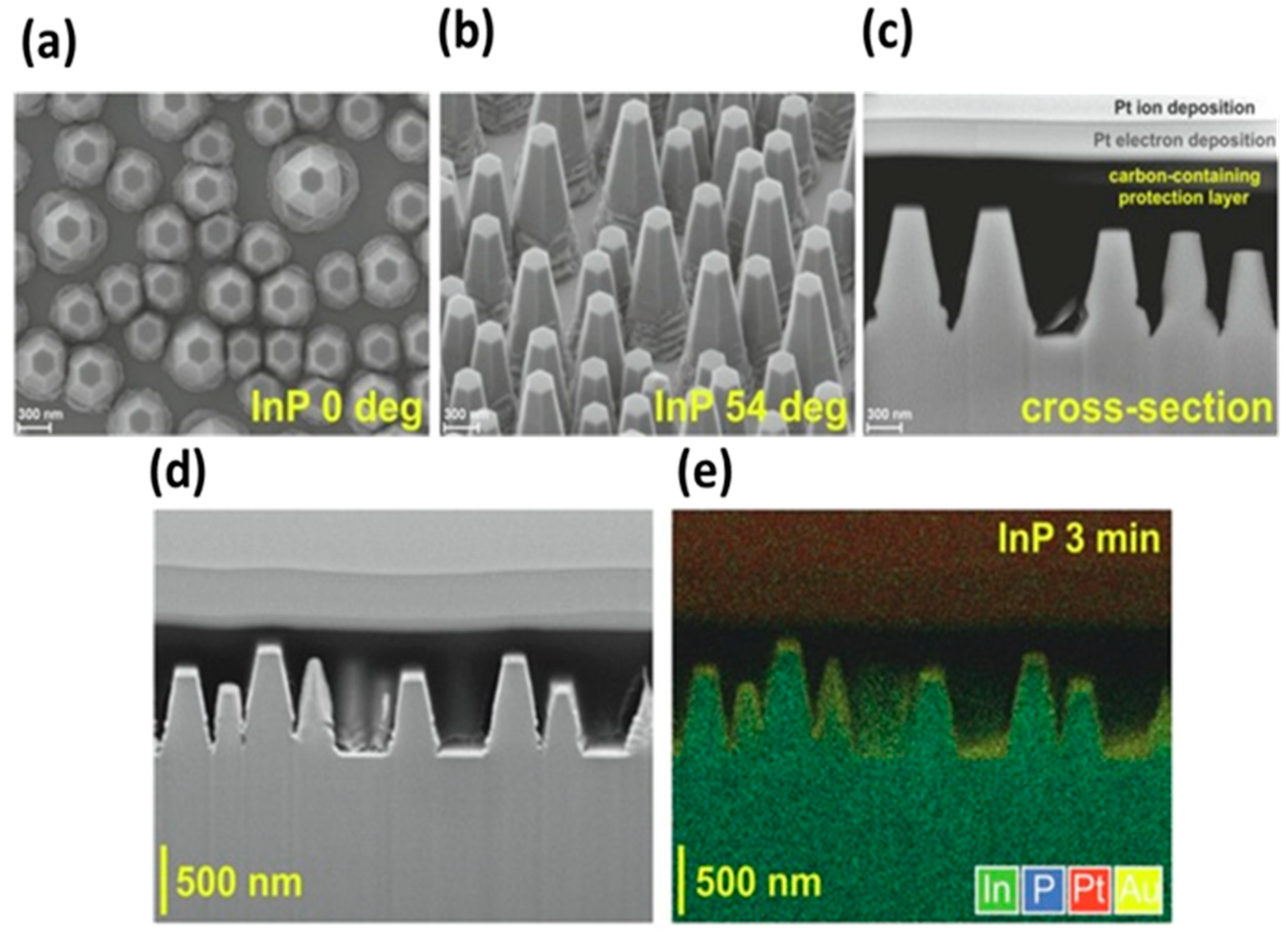
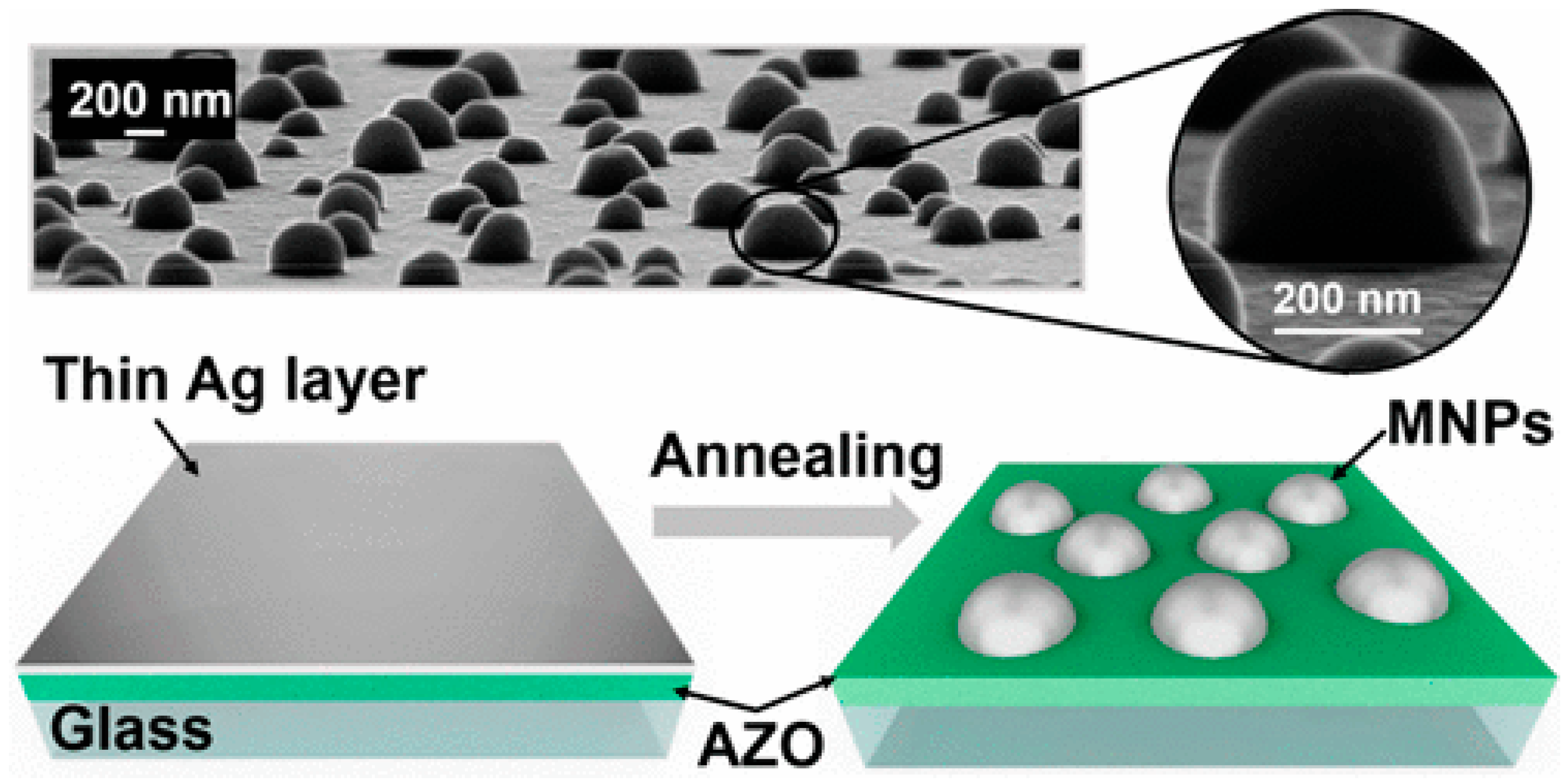
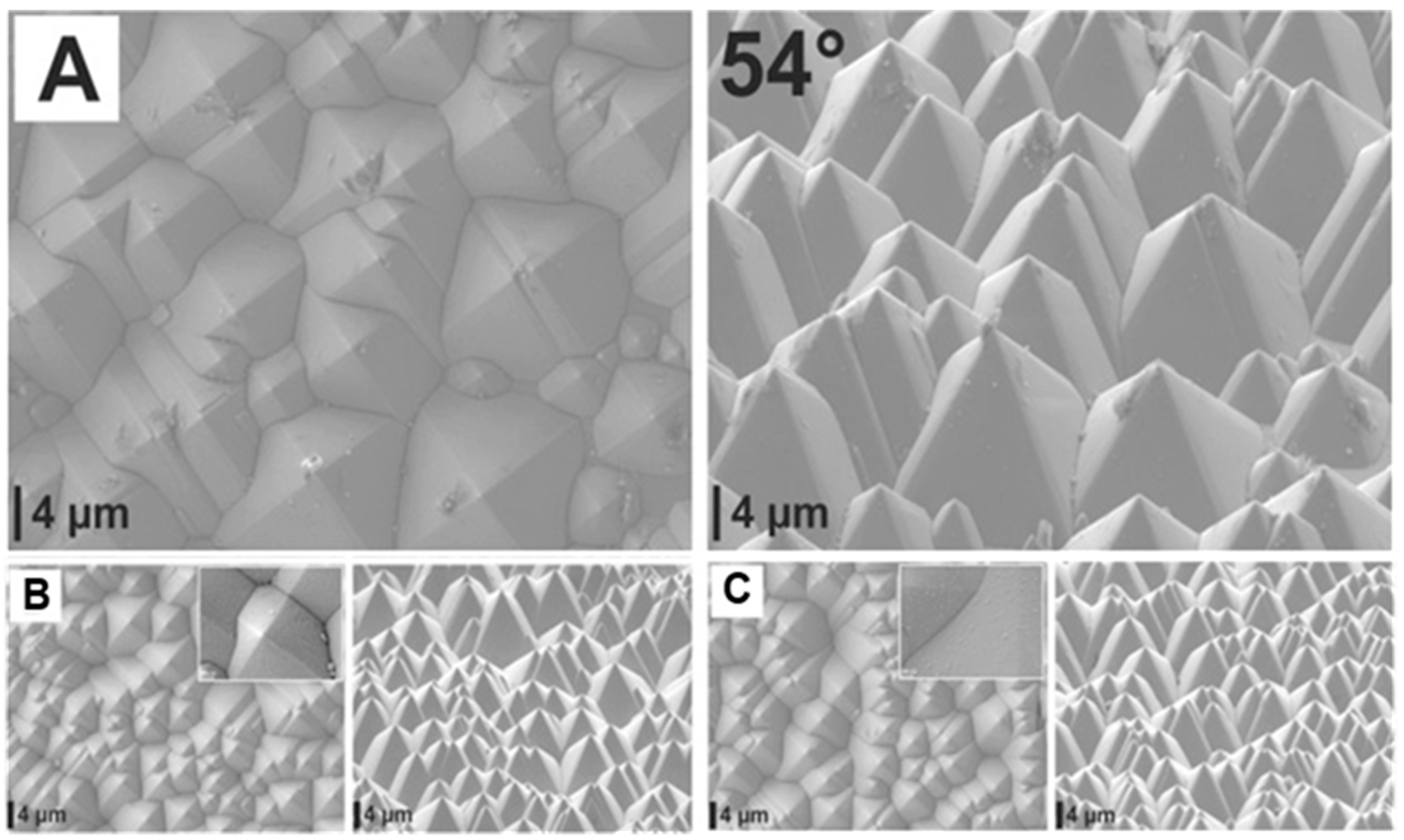

Disclaimer/Publisher’s Note: The statements, opinions and data contained in all publications are solely those of the individual author(s) and contributor(s) and not of MDPI and/or the editor(s). MDPI and/or the editor(s) disclaim responsibility for any injury to people or property resulting from any ideas, methods, instructions or products referred to in the content. |
© 2023 by the authors. Licensee MDPI, Basel, Switzerland. This article is an open access article distributed under the terms and conditions of the Creative Commons Attribution (CC BY) license (https://creativecommons.org/licenses/by/4.0/).
Share and Cite
Dumiszewska, E.; Michałowska, A.; Nozka, L.; Czolak, D.; Krajczewski, J. Plasmonic Modification of Epitaxial Nanostructures for the Development of a Highly Efficient SERS Platform. Crystals 2023, 13, 1539. https://doi.org/10.3390/cryst13111539
Dumiszewska E, Michałowska A, Nozka L, Czolak D, Krajczewski J. Plasmonic Modification of Epitaxial Nanostructures for the Development of a Highly Efficient SERS Platform. Crystals. 2023; 13(11):1539. https://doi.org/10.3390/cryst13111539
Chicago/Turabian StyleDumiszewska, Ewa, Aleksandra Michałowska, Libor Nozka, Dariusz Czolak, and Jan Krajczewski. 2023. "Plasmonic Modification of Epitaxial Nanostructures for the Development of a Highly Efficient SERS Platform" Crystals 13, no. 11: 1539. https://doi.org/10.3390/cryst13111539
APA StyleDumiszewska, E., Michałowska, A., Nozka, L., Czolak, D., & Krajczewski, J. (2023). Plasmonic Modification of Epitaxial Nanostructures for the Development of a Highly Efficient SERS Platform. Crystals, 13(11), 1539. https://doi.org/10.3390/cryst13111539






